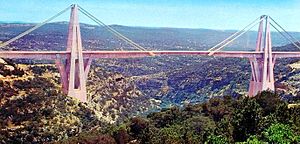Bridge over the Wadi al-Kuf
Coordinates: 32 ° 41 ′ 48 ″ N , 21 ° 33 ′ 56 ″ E
| Bridge over the Wadi al-Kuf جسر وادي الكوف |
||
|---|---|---|
| The bridge around 1970 | ||
| Crossing of | Wadi al-Kuf | |
| construction | Cable-stayed bridge | |
| overall length | 477 m | |
| width | 13 m | |
| Longest span | 282 m | |
| Clear height | 160 m | |
| start of building | 1967 | |
| completion | 1971 | |
| planner | Riccardo Morandi | |
| location | ||
|
|
||
The bridge over the Wadi al-Kuf , ( Arabic جسر وادي الكوف, DMG Ǧisr Wādī l-Kūf ), is a road bridge in Libya . It is a significant example of by Riccardo Morandi created cable-stayed bridges in prestressed concrete . It had the greatest clear height of all bridges in Africa until it was exceeded in 1984 by the Bloukrans Bridge in South Africa.
location
The bridge is part of the road connection from Benghazi via El Merdj , Al-Baida and Darna to Tobruk in the far north of Libya and is located on the section of the road, also known as Al-Orouba Road , about 20 km west of al-Baida and 15 km south of the coast over the deeply cut Wadi al-Kuf in the mountains of the Jebel al-Achdar .
description
The bridge crosses the Wadi al-Kuf at a height of 172 m. It is 477 m long, its span is 282 m.
Its two pylons tower over the roadway by 57.30 m, but they are not the same height as their foundations on the slopes of the wadi are at different heights. Their A-shaped structure made of prestressed concrete gives them the necessary rigidity to absorb the variable lateral loads that arise when vehicles driving over the bridge first load the bridge deck in front of the pylon and then the part behind it. For the same purpose, the bridge deck is supported by the V-shaped structures arranged between the pillars of the pylons.
In contrast to the usual steel lattice girders or steel box girders , the bridge deck is also made of prestressed concrete, namely a box girder with a 7.40 m wide lower chord on which a 13 m wide plate is arranged as a girder.
The diagonal bracing does not consist of wire ropes, but of prestressed concrete rods , which prevents the ropes from vibrating, which particularly stress the rope connections on the pylons and on the bridge deck. These inclined bars are attached to the bridge deck at a distance of 97.5 m from the pylon axis.
As part of the cable-stayed bridge, the bridge deck is a tanner girder . From the pylons, the two halves of the bridge deck protrude 16 m each beyond the connection of the diagonal bracing. The remaining gap is closed by a 55 m long suspension bracket .
history
The Jebel-al-Achdar is an inaccessible, cave-rich area that was the center of the long-term resistance under Umar al Muchtar against the Italian colonial power . The bridge is therefore often named after him. It was built a few years after the first oil discoveries in the Kingdom of Libya under King Idris between 1967 and 1971. The building planned by Riccardo Morandi was built by Costruzioni Stradali e Civili SA from Lugano , a subsidiary of the Italian Cogefar , which later became part of Impregilo .
In 1999 the bridge was overhauled after ground movement affected its mean span. The pink paint was changed to a light gray.
After an inspection, the bridge was closed to traffic by the state authorities in Libya in 2017.
Web links
- Wadi Kuf Bridge on Highest Bridges.com
Individual evidence
- ↑ a b c d Marcel Prade: Les grands ponts du monde . Deuxième partie, Hors d'Europe. Brissaud à Poitiers. ISBN 2-902170-68-8 , p. 30
- ↑ Marcel Prade gives the clear height as 160 m, while Highest Bridges gives 172 m.
- ↑ Authorities in east Libya close Wadi el Kuf Bridge for safety reasons , The Lybia Observer, October 26, 2017


